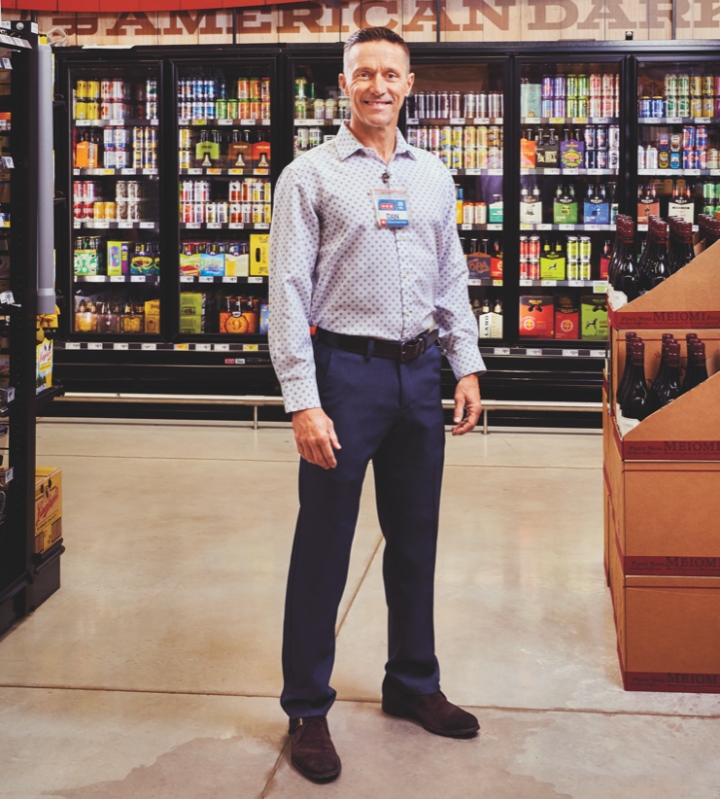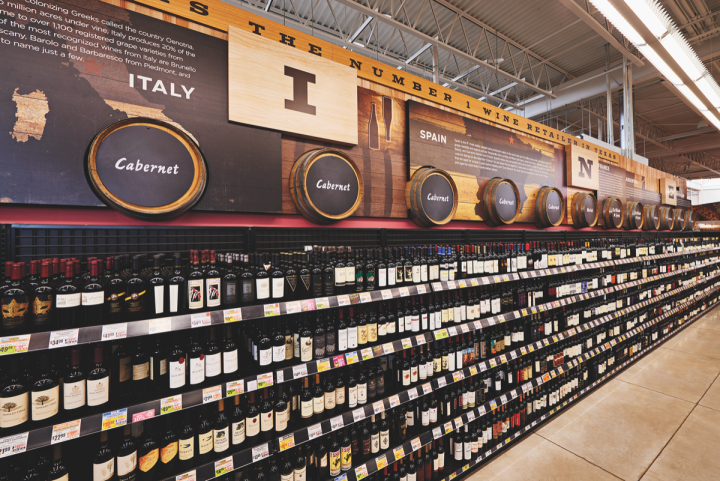
When Florence Butt opened the C.C. Butt Grocery store in the small Central Texas town of Kerrville in 1905, it would’ve been hard to imagine the shop eventually ranking as one of the largest retailers in the United States. More than a century later, however, the family-owned H-E-B Grocery Co.—named after Florence’s youngest son, Howard Edward, who initiated expansion in the 1920s—operates roughly 330 full-service grocery stores across Texas under its main H-E-B banner, as well as nine upscale Central Market locations, run as a separate division, and 55 H-E-B units in Mexico. H-E-B remains an active family business, with Butt members currently serving in top leadership roles.
Driven by its mission of providing customers with the complete grocery experience, H-E-B began selling beer and wine in the late 1970s. While that department’s recent sales figures remain undisclosed, industry sources estimate H-E-B’s beer and wine sales at around $1 billion (Texas law prohibits the sale of spirits in grocery stores). A 21-year company veteran who’s worked in various departments, Dan Schuette currently serves as director of H-E-B’s wine and beer department, following a consolidation of the two categories about a year ago. He oversees an eight-person management team spread over various Texas regions and roughly 180 beer and wine stewards working across 130 stores. For his attentive dedication to the beverage alcohol category, Dan Schuette has been named a 2017 Market Watch Leader.

Catering To The Local Market
H-E-B strives to provide a customized shopping experience at each of its locations. While some stores cover 35,000 square feet and offer a more limited product selection, others can span 185,000 square feet, space and consumer demand permitting. “One of the things we’re known for as a company is that we tailor each store layout and assortment—including beer and wine—to what we think is right for its specific market, from small towns to pocket neighborhoods in large cities like Houston,” Schuette says. “For example, I have about 800 wines in addition to my standard assortment, but we only sell them in certain areas across the state where demand exists.”
As many Texas cities have seen major population booms, H-E-B has expanded right along with them. Houston has been the company’s largest growth market over the past decade, followed by Austin, where H-E-B is noticing an influx of people moving from the West Coast. While H-E-B remains in solid growth mode, company and real estate planning require strategic thinking about which markets to enter. The company currently has no stores in the El Paso market, and in the Dallas-Fort Worth metro area it operates only four Central Market units. However, H-E-B says it has a couple of new stores planned for the fast-growing San Antonio market, where the company is headquartered, and it opened a new store in Midland last year after the city had grown enough to support a second location.
Thanks to each store’s uniqueness, H-E-B sees nearly every type of consumer coming through its doors. “Because we sell a lot of alcohol at all different demographic levels, we tailor our selections to a location’s customer base,” Schuette says. “My goal is to take care of every customer, whether they want a $3 bottle of wine or a $300 bottle.” Some locations see 80 percent of alcohol sales derived from beer and 20 percent from wine, but depending on the local demographics, that ratio can be flipped. A typical layout devotes about 60 percent of space to wine and 40 percent to beer. As a neighborhood’s average income increases, so does the percentage of wine sales.
A standard location will typically carry about 1,300 wines and 750 beers, but those numbers vary significantly from one store to the next. The H-E-B unit in Houston’s Village Plaza at Bunker Hill is a top-selling wine location with 2,500 SKUs, and the company continues to actively expand that selection. Meanwhile, two H-E-Bs in San Antonio and New Braunfels, where there’s a strong outdoor culture, are among the top-selling beer stores with 950 SKUs. Overall beer sales are larger than wine, but Schuette says he expects the two categories to roughly equal each other within the next three to five years given current growth trends.
By adjusting its beer and wine selections and paying attention to small details, H-E-B has been able to remain competitive with independent alcohol retailers. Schuette and his team deliberately seek out products that aren’t on the national radar yet. The beer and wine department also works to match all other retailers’ prices in every market.

Wine's Growing Share
H-E-B has been the state’s largest retailer of wine in sales and volume for many years running. Each store’s wine assortment can vary from 100 to 200 wines in a small unit where the local demographic prefers beer to locations with upwards of 1,800 standard wines and another 100 to 150 rotating labels. The company resets its wine assortments on a planned basis every two years, when it typically adds a couple hundred new wines while culling low performers and restructuring layouts. Every six months, the wine department also switches out roughly 20 to 50 wines. “We try a lot of new things, and if they don’t work, we get out of them fairly quickly and add something new,” Schuette says.
Throughout H-E-B’s vast wine department, products can range from Lindeman’s Bin 65 Chardonnay ($3.33 a 750-ml.) to Dolce Late Harvest Wine ($74.49 a 375-ml.). Schuette and his team are particularly interested in working with family-owned wineries and small-lot producers. H-E-B has featured such limited releases as the Dominus Cabernet Sauvignon ($229), sold at 20 stores, and Roederer Cristal Champagne ($209), carried at 25 stores. While $10 a bottle is the department’s pricing sweet spot, growth is increasingly coming from wines over $20. Schuette says consumers are getting more comfortable with purchasing high-end wine from a grocery store, which would have been unheard of a decade ago.

Cabernet Sauvignon is H-E-B’s most popular varietal, and some featured selections include 19 Crimes ($11.98 a 750-ml.), Legend of the Vine ($12.98) and Stag’s Leap Winery Cask 23 ($248.99). Chardonnay follows as a strong second. Schuette says he’s also seen rosé take off across the state in recent years, with all regions and price points soaring. “Rosé is a year-round wine now, and it’s been that way for us for three or four years,” Schuette says. “I’m selling a ton of rosé in February for Valentine’s Day because it’s still warm enough here in Texas at that time of year.” Some featured rosés include Finca El Origen Estate Malbec Rosé ($7.98), Mimi en Provence Grande Reserve rosé ($14.98) and Los Dos Rosé ($8.98). Sparkling wines have grown in popularity across H-E-B stores, including Tott’s Brut California Champagne ($7.98), Prima Mazzo Pink Moscato ($11.98) and La Marca Prosecco ($12.07).
H-E-B’s overall wine selection is roughly 60-percent domestic and 40-percent imports, although imported wine’s share is growing. Italy is the most popular region—with selection ranging from Riunite Lambrusco ($4.77 a 750-ml.) to Marchesi Antinori Solaia ($293.99)—followed by Spain and France. Australia is starting to show signs of a turnaround for its high-end wines, but sales of Argentine and Chilean wines are on the downswing in H-E-B’s markets.
The domestic side’s assortments are heavy in West Coast wines, but Schuette likes to feature local Texas wineries as well. In some of the company’s top-performing wine stores, about 50 to 80 Texas wineries are represented. “We want to do the same thing that Washington and Oregon retailers did to support their local wines,” he says, noting that the quality has improved as local wineries focus on varietals like Tempranillo, which do well in Texas’ hot climate. Examples of featured Texas wines include Becker Vineyards Cabernet Sauvignon ($18.98 a 750-ml.), Lost Maples Chardonnay ($9.98) and Lost Maples Red Blend ($7.98).

Heavy Craft Influence
Beer has always been big with Texas consumers, and H-E-B is seeing craft play an increasingly important role in sales. “We’re more profitable than we were even two years ago,” explains Schuette, who credits the growth to craft. “Consumers are just loving it.” The challenge for H-E-B’s beer buyer Rusty Woodland and the team, however, is the limited brand commitment among craft beer drinkers, who tend to experiment with styles and breweries. While domestic premium brands are still a sizable segment for H-E-B, they’re struggling against rising demand for craft beers. Popular local breweries include Austin’s Independence Brewing Co., Blanco’s Real Ale Brewing Co., Shiner’s Spoetzl Brewery and Houston’s Saint Arnold Brewing Co. But large national craft breweries like Lagunitas, Dogfish Head and Stone provide major growth avenues for the company as well.
Because of craft’s diversity of styles, it’s difficult to pinpoint a particular one that stands out. IPAs remain popular, but the styles carried in H-E-B stores are evolving. “Craft beer customers are so willing to move around between different styles, and a lot of it is situational and event-driven,” Schuette says. “Am I going to be out in the hot sun all day drinking a session beer or am I going to be relaxing in air conditioning with a stout? It’s a challenge to meet those diverse needs.” For beers that are sessionable, he encourages brewers to consider canned formats to fit into outdoor activities. H-E-B carries many craft beers in both cans and bottles if there is space and demand for it.

Endless Opportunities Ahead
Being part of a full-service grocery retailer allows the beer and wine department to team up with other H-E-B divisions for continuous in-store events like tastings that feature 1-ounce pours and demonstrations. Some locations offer specialty foods, salespeople who focus on food and wine pairings, and cooking lessons from chefs or other highly trained culinary staff. “That’s been a fantastic solution for how we can get customers to think of wine more often in the store and to have them think of it more with food in general,” Schuette says. H-E-B has also been expanding its beer and wine stewards program, which features trained staff who offer education and pairing recommendations, as well as helping track down hard-to-find wines.
H-E-B’s focus on local products means it is also constantly looking for ways to reinvest in communities across the state. Since the 1930s, H-E-B has donated 5 percent of its pretax earnings to charity. The company also contributes to a number of initiatives such as the H-E-B Food Bank Assistance Program, United Way, Habitat for Humanity and the Spirit of H-E-B trailer, which services areas devastated by natural disasters. Other nonprofit groups include organizations and programs that emphasize education and environmental conservation.
Part of the company’s success stems from its ability to adapt to an evolving and expanding marketplace. Schuette says he’s keeping an eye on potential changes in Texas law regarding direct-to-consumer sales and looser on-premise consumption regulations, as well as the possibility of spirits sales in grocery stores stemming from ongoing litigation. “You’re always going to see us finding more ways to focus on the customer,” he says. But whatever changes sweep the Texas beverage market, Schuette and his team will continue to support the H-E-B brand that has thrived in the state for over a century.